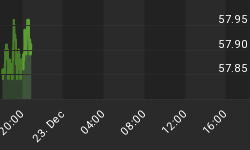One of the defining characteristics of fractal patterns is their self-similarity on every scale; that is, the smaller structures have the same shapes and patterns as the larger structures. In financial markets, it is impossible to know the time-frame on an unlabeled chart, as it could be a 5 minute chart, a daily chart, or even a quarterly or yearly chart. The patterns are the same.
We're seeing a great example of this right now on the 150-minute and daily charts of gold, as the dominant fractal patterns on these charts are nearly identical. It's not too surprising that gold has similar structures on both the shorter-term and longer-term charts, as gold is dealing with a strong corrective pattern that is dominated by sudden streaky declines.

The daily gold pattern is quite familiar at this point, as gold continues to seek equilibrium after the massive 3-day decline from the $1,034 peak. Since markets constantly oscillate between trending periods (linear movement) and non-trending consolidation periods (non-linear movement), the very sharp and linear decline in gold requires a long consolidation period to counter-balance and dissipate that huge rush of energy.

We can see at a glance that the 150-minute chart is showing a nearly-identical fractal pattern as the daily chart, with a strong decline followed by a sideways consolidation near the lows.
I use this 150-minute chart to characterize the short-term trends, as financial markets typically move in a 3-to-5 day "rhythm" of trend and consolidation that is well-described by the fractal dimension on the 150-minute chart.
Friday's decline in gold appears to be significant on the daily pattern, but relatively small in comparison to the big initial decline. Yet on the 150-minute chart Friday's decline looms very large. And just like on the daily pattern, the sideways consolidation is mired in the lower ranges of the decline. This strongly suggests that the next burst of trending energy will again be to the downside.
The fractal dimension readings on these two charts also confirm that another free-fall decline could spark to life at any moment. We've been aware of the importance of the $910 energy level on this pattern for quite some time, and this level should again be a critical balance point.
The main hope for the immediate bullish case is for $910 to continue to hold up as an upside "slingshot" level. In more technical parlance, $910 is an attractor/repeller for the current fractal pattern in gold, as price has been both attracted to this level and repelled away from it.
I call these slingshot levels, as this is a more intuitive way to grasp the idea that a rapid move down to a critical energy level like $910 can spring-load a very strong rebound.
If $910 has lost its slingshot power, then gold could have a much bigger problem, as the next really powerful attractor is all the way down at $852. This means that a break under $910 should trigger a very swift decline to $852.
This big corrective pattern in gold has already shown a tendency to plummet very quickly after such a breakdown. You may recall our recent short trade, and how a quick decline to $882 was predicted after the breach of $940, and how that seemingly far-off downside target was hit in just over a day, with a harrowing free-fall drop.

The hourly chart of that decline also illustrates how even a volatile market like gold almost always offers an opportunity to get positioned around these critical energy levels. After the initial breach of $940, prices climbed back up for one last touch -- the "kiss goodbye" -- prior to the plummet down to $882.
In this current situation, a breach of $910 will be a similar strong warning that gold is heading quickly for $852. If we see such a breakdown below $910, followed by a brief grinding-type move back up to $910 from below, then that will be a prime set-up for a short position.

As with all short positions, I recommend you keep the position size relatively small, and you only trade this set-up if you can be extremely vigilant about following the trading in real-time. (Note: subscribers have access to an "auto-trade" program.)
As far as the upside, I'm still looking for a move over $940 before I'll even entertain the idea of getting back on that side. This looks to be major corrective pattern, and there are almost certainly more free-fall drops coming in gold, so we have to be extremely careful about long positions at this stage in the developing pattern.
















